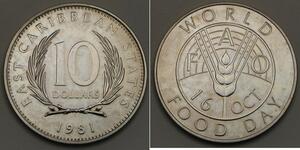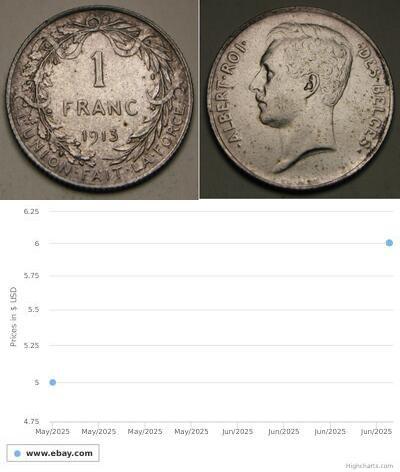(Vendida por $157.0)
1740, Emperor Charles VI. Scarce Silver 1/4 Thaler Coin. Nagybanya mint!
Mint Year: 1740
Reference: KM-305. R!
Denomination: 1/4 Thaler
Condition: A nice VF-XF!
Mint Place: Nagybanya (Transylvania)
Diameter: 30mm
Material: Silver
Weight: 6.93gm
Obverse: Laureate and draped bust of Charles VI to right, with Order of the Golden Fleece at chest.
Legend: COROL . VI . (Madonna) D:G . R : IMP . (1/4) S : A : GE : HI : (crowned hungarian shield) HU: B : REX .
Reverse: Large crown above double headed eagle with crowned coat-of-arms at chest. Mint initials (N-B) in felds below claws.
Legend: ARCHID : AUS : BU : M : MOR : CO : TYR : 1740 .
The first mention of Nagybanya is from 1142, when King Géza II of Hungary settled it with Transylvanian Saxons. The name of the settlement was Frauenbach in German (Asszonypataka in Hungarian, Rivulus Dominarum in Latin), meaning “River of the Ladies” or “Women's Brook”. The richest documentation, however, is found in the act of privilege issued by Louis I of Hungary in 1347. King Sigismund, Holy Roman Emperor, as part of treat with serbian ruler Despotus Stefan Lazarevic, gave him Nagybanya as a gift at 1411., until Depotus' death in 1426. A year after, lord of Nagybanya became Stefan's succesor Despotus Ðurad Brankovic of Serbia.. A document from that year speaks of the Mint in Baia Mare, one of the oldest and most famous in Transylvania. In 1446, the mines and domain of Baia Mare became the property of the Hunyadi family as a token of gratitude for the bravery shown by John Hunyadi in his battles against the invading Turks. John Hunyadi commissioned the Saint Stephen cathedral whose Stephen Tower remains a landmark of the city to this date. In 1469, King Matthias Corvinus of Hungary bestowed upon the city the right to develop its defense system by erecting fortified walls and keeps, strengthened by deep moats and large palisades to keep out the invaders. Baia Mare thus became an impressive fortress. In 1567, it was annexed by John Zsigmond, prince of Transylvania. The city was in Szatmár County of the Kingdom of Hungary. In 1600, as a sign of gratitude for having cancelled several of the city's debts, the tenant of the local mines, Felician Herbstein, ordered a coin to be minted in gold, displaying the effigy of Michael the Brave (Mihai Viteazul), voivod of Wallachia. Collectors agree that this is an effigy of the prince of great numismatic value. Between the years 1605 and 1606, 1621 and 1629, and 1645 and 1648, the city and the surrounding county was part of the Principality of Transylvania. From the 16th century the settlement was officially called Nagybánya. In 1703, the legendary outlaw, Pintea the Brave (Pintea Viteazul), was witness, alongside Francis II Rákóczi, to the freeing of the city from the hands of the Austrian Habsburgs during a kurucs war.
Charles VI (German Karl VI) (October 1, 1685 – October 20, 1740) was Holy Roman Emperor, King of Bohemia (as Karel II.) and Hungary (as Károly III.) from 1711 to 1740. From 1703 to 1711 he was an active claimant to the throne of Spain as Charles III.
Charles was born in Vienna, the second son of the Emperor Leopold I and of his third wife, Princess Eleonore-Magdalena of Palatine-Neuburg. He was given the baptismal names Karl Franz Joseph Wenceslau Balthasar Johann Anton Ignatius. His tutor was Prince Anton Florian of Liechtenstein.
Charles was the contracted heir of the Spanish Habsburgs. When Charles II of Spain made Philip V his heir, Louis XIV violated the contract. The dispute for the crown of Spain led to the War of the Spanish Succession.
After his older brother the Emperor Joseph I died suddenly in 1711, Charles returned to Austria. He succeeded immediately as King of Hungary and King of Bohemia. Later that year he was elected Holy Roman Emperor in Frankfurt.
Although Charles seems to have been clumsy in political affairs, the Austrian monarchy reached its widest expansion during his reign. His superior army was defeated by Bosnians in year 1737 in Battle of Banja Luka.
He married Elisabeth, eldest daughter of Louis Rudolph, Duke of Brunswick-Lüneburg. At the time of his death, his only surviving children were Maria Theresa and Maria Anna, so he had no living male heirs - a situation he had guarded against in the Pragmatic Sanction of 1713, which stated that his realm could not be divided and allowed that daughters also could inherit the throne from their fathers. When he died, the War of the Austrian Succession took place, but in the end the Pragmatic Sanction held up and his daughter succeeded him as Queen of Hungary and Bohemia and Archduchess of Austria. However, being a female, she was not elected Holy Roman Empress. Instead, Charles VII was elected. However, after Charles VII's reign, Maria Theresa's husband Francis III Stephen, Duke of Lorraine, was elected, ensuring that the Empire would continue in the Habsburg line.
Probably as a consequence of his years in Spain, he introduced the Spanish court ceremonial (Spanisches Hofzeremoniell) in Vienna and built the Spanish Riding School. Furthermore, the Reichskanzlei ("chancellory of the state") and the National Library were constructed during his reign and the Michaeler tract added to the Hofburg. Much was designed in baroque style in Vienna during Charles' reign.
He also had musical ambitions. Taught as a boy by Johann Joseph Fux, he composed, played the harpsichord, and now and then conducted the court's band.
There is some evidence that Charles' death was caused by consuming a meal of death cap mushrooms.
Karl succeeded more as a musician than as a statesman. He composed, played the harpsichord, and conducted the court band. Unfortunately, he performed those functions when he should have been leading the nation.
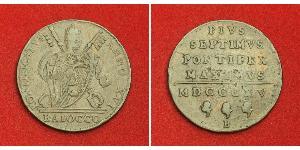
1 Baiocco Estados Pontificios (752-1870) ...
grupo tiene 5 monedas / 5 precios
Add coin to this group
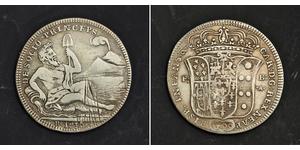
1/2 Piastre / 60 Grana Italian city-stat ...
grupo tiene 2 monedas / 2 precios
Add coin to this group

20 Kreuzer Electorate of Bavaria (1623 - ...
grupo tiene 5 monedas / 3 precios
Add coin to this group

8 Real Bolivia Plata Felipe IV de España ...
grupo tiene 2 monedas / 2 precios
Add coin to this group
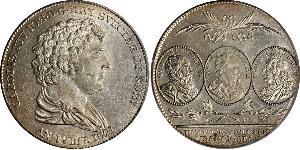
1 Riksdaler United Kingdoms of Sweden an ...
grupo tiene 2 monedas / 1 precios
Add coin to this group
Una de ellas es











